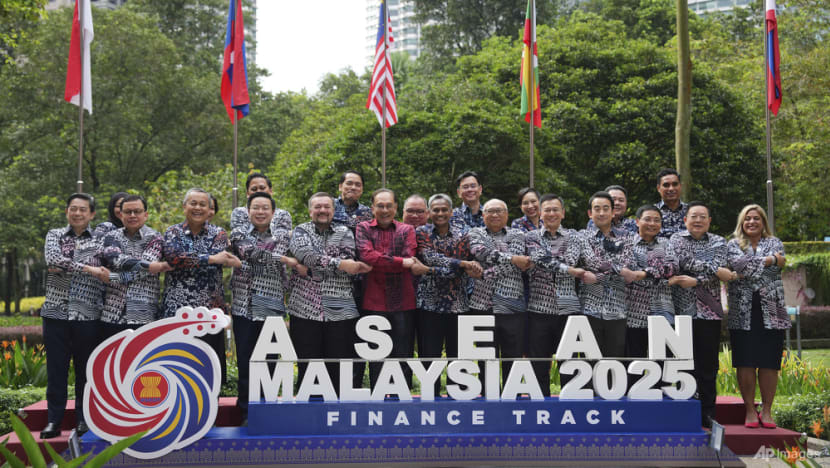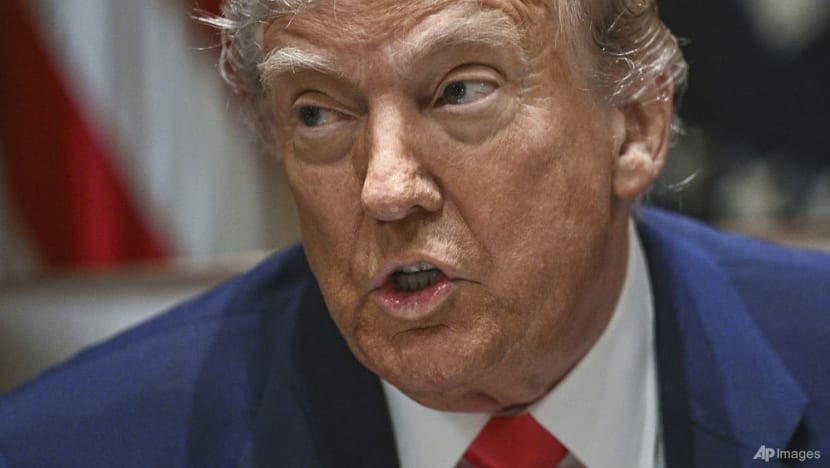With Trump's unpredictability, ASEAN’s no-retaliation response to US tariffs is its only ‘realistic’ option
KUALA LUMPUR: The Association of Southeast Asian Nations (ASEAN)’s hybrid approach to the United States’ recent trade tariffs is the most realistic approach for its member nations, said analysts.
Speaking with one voice to highlight the bloc's shared concerns while allowing member states to negotiate individually based on their own interests, aims to maintain dialogue and avoid escalating trade tensions, the experts told CNA.
They added that ASEAN’s decision not to impose retaliatory measures against the US' recent trade tariffs also reflects a pragmatic assessment of the regional bloc's influence and priorities.
“ASEAN’s response to the US tariffs has been measured rather than confrontational, but that doesn’t mean the region is being too soft,” said Joanne Lin, senior fellow and co-coordinator of the ASEAN Studies Centre in Singapore’s ISEAS-Yusof Ishak Institute.
She said that in terms of negotiating clout, ASEAN’s strength lies not in economic muscle per se, but in its strategic relevance as the fifth largest economy in the world and one that represents a market of over 670 million people and plays a critical role in global supply chains
“As a grouping, it can certainly shape the broader narrative, especially by reaffirming the principles of a rules-based economic order and trade openness,” she added.
“However, under a Trump administration that favours bilateral, transactional deals, ASEAN’s most realistic approach is a hybrid one, for example, speaking with a common voice to highlight shared concerns while allowing member states to negotiate individually based on their own interests.”
Experts added that this was the best stance to take given the unpredictability of US president Donald Trump, who on Wednesday (Apr 9) paused reciprocal tariffs that had been recently declared for 90 days, with the exception of China.
ASEAN’s response has been under spotlight given how some of the countries in the bloc were unexpectedly hit hard by the US tariffs.
On Thursday, the bloc said that it would not impose any retaliatory measures in response to the swathe of tariffs imposed by the US, although it was concerned by the developments.
The grouping of Southeast Asian nations said it was their common intention to engage in a frank and constructive dialogue with the US to address trade-related concerns.
“Open communication and collaboration will be crucial to ensuring a balanced and sustainable relationship. In that spirit, ASEAN commits to not impose any retaliatory measures in response to the US tariffs,” it said in its statement on Thursday after a special meeting that was attended by the economic ministers of all 10 ASEAN member states and Timor-Leste, as well as the secretary-general of ASEAN.
Timor-Leste has been granted observer status and in-principle approval to join the bloc.
Some analysts have previously told CNA that ASEAN as a bloc is not seen by the US as a key global player, and the countries' differing trade circumstances imply it would be more constructive for member states to negotiate with Washington directly.
Several recently published commentaries have taken a scathing tone against the prospect of a joint ASEAN bloc response to the tariffs, with one Jakarta-based journalist arguing that the US is unlikely to care about ASEAN’s response as a group.
Others noted that ASEAN is not a customs union or formal trade bloc like the European Union (EU) - which has centralised trade policy mechanisms - and thus could find it harder to impose joint retaliatory tariffs if it wants to, especially given ASEAN’s consensus decision-making process.
RETALIATORY MEASURES COULD HARM ASEAN
There were a few options that ASEAN could have taken towards the tariffs.
These include retaliating against them, as China has done, engaging in diplomatic negotiation with the US, seeking intervention by the World Trade Organization (WTO), and diversifying its export markets.
But Lin said that ASEAN would avoid retaliatory measures, partly because the bloc operates by consensus and partly because most of its member states, especially the smaller economies, do not have the economic clout to engage in tit-for-tat trade responses like China without risking self-harm.
“Retaliatory tariffs would likely disrupt domestic industries and supply chains more than they would pressure the US to reverse its course,” she said.
The US is ASEAN's second largest trading partner, with total trade at an estimated US$476.8 billion in 2024.
James Chin, professor of Asian studies from the University of Tasmania, told CNA that ASEAN’s action was the most realistic, especially as Trump keeps on changing his mind on issues.
“Even if you retaliate, he can keep changing his mind. So you will always be playing catch up. The best thing to do is keep your head low and do nothing,” said Chin.
On Apr 2, Trump announced a new 10 per cent baseline levy on all imports coming into the US as well as country-specific taxes on goods from a host of other countries dubbed “reciprocal” tariffs.

Southeast Asian countries were among the worst hit economies, with Cambodia and Laos slapped with 49 per cent and 48 per cent import tariffs respectively. This was followed by Vietnam (46 per cent), Myanmar (44 per cent) and Thailand (36 per cent).
Malaysia and Brunei were hit with 24 per cent tariffs, while the Philippines and Singapore were hit with tariffs of 17 per cent and 10 per cent, respectively.
This was before Trump paused these “reciprocal tariffs” for 90 days, except for China.
Chin for one believed that even if ASEAN came together collectively, the nations were not big enough to challenge the US.
“Many countries in ASEAN do not want to challenge the US because they benefit from US trade tremendously. The chip companies ran away from China and set up in Malaysia because they wanted to export to America,” he said, adding that ASEAN countries will always be dependent on the big powers because it is not possible for their economies to be self-reliant.
However, reacting to the tariffs with further tariffs would not be beneficial for anybody, according to some experts.
“Tariffs are never a solution, even as a countermeasure. Obviously the US is the most important export market for most of the ASEAN countries, said Carmelo Ferlito, the chief executive of the Center for Market Education - a think tank based in Kuala Lumpur.
“It is good to look for dialogue and most probably this is what the US wanted since the beginning. It wanted to force countries that revolve around China to look back to dialogues with the US for stronger trade ties,” he said.
In 2024, trade with ASEAN countries accounted for 15.9 per cent of China’s total foreign trade - with bilateral trade reaching US$962.98 billion, according to official statistics.
IF NEGOTIATIONS WITH TRUMP DON’T WORK, WHAT CAN ASEAN DO?
Experts CNA spoke to gave examples of individual ASEAN states making moves that align with their individual priorities, without undermining ASEAN unity.
Lin told CNA: “Vietnam and Cambodia's recent bilateral moves to slash tariffs on US goods, for example, have not undermined ASEAN unity. Instead, it has shown what pragmatic deal-making can look like, especially when aligned with US priorities.”
Vietnam has proposed to cut its tariffs on US imports to zero, a proposal that the US rejected, while Cambodia has proposed that its tariffs be cut to 5 per cent.
It has also been reported that Malaysia has requested, through its Foreign Ministry, a special US-ASEAN summit to discuss the tariff issue.
Malaysia’s Minister of Investment, Trade and Industry Tengku Zafrul Abdul Aziz told CNBC on Apr 11 in an interview that all ASEAN leaders had agreed to go to the US to meet up with Trump during the summit.
“And I was made to understand from the ASEAN secretariat that now, we are waiting for the US to revert with the time,” he was quoted as saying.

But Lin said that if negotiations with the US do not yield meaningful tariff reductions, ASEAN countries would need to further diversify their export markets.
She said that many are already doing so, with China remaining a critical partner, especially for countries like Cambodia, Laos and Myanmar, which have limited US trade exposure.
However, closer economic alignment with China depends on how well these countries’ exports match Chinese demand.
Beyond China, the EU, India, the Gulf States, and deeper intra-ASEAN trade represent key alternatives, according to Lin.
“Strengthening the implementation of the Regional Comprehensive Economic Partnership (RCEP) and exploring new free trade agreements will be essential to reduce vulnerability to unilateral protectionist actions,” she said.
The RCEP is a free trade agreement that includes all 10 ASEAN member states, China, Japan, South Korea, Australia, and New Zealand.
However, geopolitical expert Oh Ei Sun said that it will be difficult for ASEAN to look for other markets to trade with instead as the US will remain one of the biggest markets for popular exports from Southeast Asia, such as semiconductors and solar products.
“ASEAN is already trading with many other countries. The problem is these countries simply can’t match the huge level of American consumption,” said Oh.
To minimise the broader impact of US tariffs, Lin said ASEAN should continue to invest in regional economic integration, strengthening internal supply chains, improving infrastructure and harmonising regulations to enhance its attractiveness as a diversified and resilient production base.
She said that while a WTO challenge is theoretically possible, the current state of the WTO’s dispute settlement mechanism and the drawn-out nature of such proceedings make it a less practical option in the short term.
While ASEAN as an organisation does not have the legal standing to file a complaint at the WTO, individual member states have the right to file complaints against other members.
Lin said that ASEAN should instead focus on deepening strategic partnerships, improving trade facilitation and use platforms like the ASEAN Committee in Washington DC to present coordinated messaging to US policymakers.
The challenge will of course be to remain cohesive, agile and forward-looking in such a volatile trade environment,” she said.
Ferlito said that the most beneficial course of action now is to aggressively pursue genuine free trade agreements with all willing partners. These agreements, he explained, enable tariff-free trade between participating nations.
“That is the way to go if we want to expand, to respond and to create more opportunities for growth, which comes from bigger markets and this comes from free trade.
“The world is integrated and to look for self-reliance is utopic and not the way to go. Economic growth is made by looking outward and not inward. So being economically strong means being integrated and not isolated,” he said.
Analysts however warned that should the ongoing tariff tensions between the US and China erupt into a full-scale trade war, there could be serious implications for the ASEAN region.
“That is a far more dangerous question because a majority of ASEAN countries rely on Chinese trade and rely on Chinese capital. If the (relations between) US and China blow up, ASEAN would definitely be hit as collateral damage,” said Chin.
Additional reporting by Amir Yusof
Disclaimer: Investing carries risk. This is not financial advice. The above content should not be regarded as an offer, recommendation, or solicitation on acquiring or disposing of any financial products, any associated discussions, comments, or posts by author or other users should not be considered as such either. It is solely for general information purpose only, which does not consider your own investment objectives, financial situations or needs. TTM assumes no responsibility or warranty for the accuracy and completeness of the information, investors should do their own research and may seek professional advice before investing.
Most Discussed
- 1
- 2
- 3
- 4
- 5
- 6
- 7
- 8
- 9
- 10